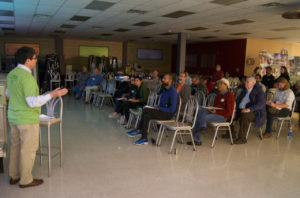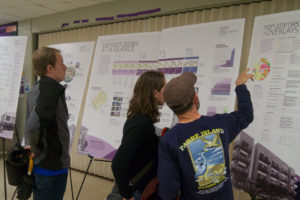 As the process for rewriting a new Land Development Code for Austin continues, City officials are making great efforts to ensure that residents have opportunities to learn the basics about it, ask questions and provide input. The series of Community Open House Events are part of that process. On Saturday, March 4th, the third open house took place at LBJ High School in District 1.
As the process for rewriting a new Land Development Code for Austin continues, City officials are making great efforts to ensure that residents have opportunities to learn the basics about it, ask questions and provide input. The series of Community Open House Events are part of that process. On Saturday, March 4th, the third open house took place at LBJ High School in District 1.
The main speaker, Greg Guernsey, the Director of the City’s Planning and Zoning Department, began with a history lesson about land development codes in Austin. Guernsey said the last major code rewrite took effect in 1985 and over the years it has become very complex and technical. He said the new code is simpler and, in keeping with the priorities outlined in Imagine Austin, it seeks to make Austin more walkable and more connected while maintaining the character of existing neighborhoods. Also, the new code is mindful of environmental concerns like water conservation and flood mitigation.
 Daryl Putnam, a resident of District 8 in Southwest Austin, made the long drive to the open house. “My main concerns are public transportation and keeping Austin Austin,” said Putnam. “With Rainey Street (redevelopment) and all it makes me think we’re losing what has attracted people to Austin because of the growth.” Putnam says he likes some of the new development, like 2nd street, which he finds very pedestrian-friendly.
Daryl Putnam, a resident of District 8 in Southwest Austin, made the long drive to the open house. “My main concerns are public transportation and keeping Austin Austin,” said Putnam. “With Rainey Street (redevelopment) and all it makes me think we’re losing what has attracted people to Austin because of the growth.” Putnam says he likes some of the new development, like 2nd street, which he finds very pedestrian-friendly.
Creating more affordable housing is a priority of CodeNEXT which HousingWorks Austin is deeply involved in through the Code Advisory Group (CAG). While the specifics are still being developed, Guernsey said the new code will create more diversity in housing choices and more incentives for developers to include affordable units in multi-family projects. Guernsey did say, however, that CodeNEXT alone will not solve Austin’s affordability crisis.
Concerns about affordability and walkability are what brought retiree Srini Shastry to the open house. He’s now renting and he’s planning to buy a home somewhere in the city. Shastry says because he’s aging he wants to make sure he’s in an area where he doesn’t have to drive to access the goods and services he needs.
CodeNEXT Project Manager Jorge Rousselin followed with a basic outline of the new code with its hybrid system of form-based and use-based zoning districts. “We’re trying to create a code that not only reduces the number of base districts but also makes them more understandable and predictable in terms of adjacency predictability-what’s going to happen next door to me,” said Rousselin. Residents’ questions about the future zoning of their own properties and neighborhoods will be much clearer on April 18th when the City releases the CodeNEXT draft zoning maps.
In the meantime, the open houses and other public events related to CodeNEXT will continue until the Council adopts the new code, which could happen at the end of 2017. You can keep track of these events and make comments about the draft code by visiting the CodeNEXT webpage at http://www.austintexas.gov/department/codenext.